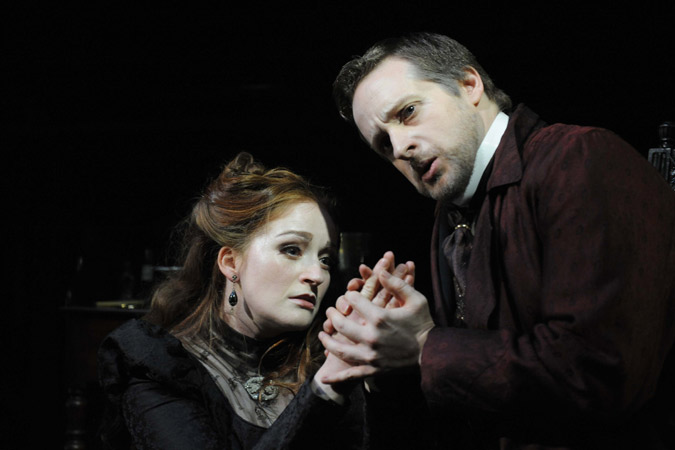Journal entries
Le Bon Journal
About
Search
Contact
Readers write
Show your support
Anne Ku writes about her travels, conversations, thoughts, events, music, and anything else that is interesting enough to fill a web page. She has written and produced two chamber operas, premiered in Utrecht, Netherlands. See her publication list for more.
Support the Bon Journal by keeping analyticalQ.com alive and free. Find out about Sponsorship or how else you can show your support
Bon Journal
Debussy's Pelléas and Mélisande at Sadler's Wells London, an Independent Opera Production
Opera in an intimate setting - is that possible?
I and my blonde guest, a professor from Finland, attended the pre-opera talk on Saturday 22 November 2008 about an hour before the final performance of Independent Opera's production of Pelléas and Mélisande. Artistic director Alessandro Talevi and orchestrator Stephen McNeff discussed their involvement in Debussy's only opera. It was the first time I had been invited to such a talk -- and I would highly recommend all operas to offer such an informative session.
Talevi had a vision. He felt that "Pelléas et Mélisande" can and should be experienced in a smaller theatre, for each scene features two, at most, three actors in a domestic setting. In a smaller theatre, the audience can experience the intimacy of a domestic scene. But how is it possible to squeeze the orchestra (with a string section of 50) into the cramped space? Debussy had lengthened the instrumental interludes to allow enough time to change the sets, but these long interludes interrupt the momentum of the dramatic development. With modern theatre technology and lighting effects nowadays, it does not take THAT much time to change the scenes. He believed that short interludes help to emphasize the individual quality of the scenes.
Talevi discussed his ideas with Madeleine Boyd, set and costume designer to build three nearly parallel floors to allow different scenes to be set on stage at once and displayed by alternative lighting. The reduced orchestra would sit beneath this staged construction but still be visible to the audience. Mobile sets such as a tree, representing the forest, a sink representing the inside of a room, would be wheeled into centre stage when necessary. He then spoke to conductor Dominic Wheeler about the music.
Wheeler contacted composer Stephen NcNeff to re-orchestrate Debussy's original score for a maximum of 35 musicians and reduce the instrumental interludes. McNeff examined the way Debussy layered and doubled the strings and woodwinds to create a whirling soundworld. By eliminating the heavy brass and auxiliary woodwinds and reallocating the music to other instruments, he was able to recreate Debussy's sound for a smaller orchestra. The result is published by Peters Edition and available for smaller productions. This new possibility is truly the contribution of Independent Opera.

Ingrid Perruche as Mélisande and Thorbjørn Gulbrandsøy as Pelléas. Photo credit: Robbie Jack
The plot of Pelléas and Mélisande is simple, but the subtleties reign deep within the underlying symbolism and complex "blended" family history. Widower Golaud, grandson of King Arkel, discovers a young maiden Mélisande alone and weeping in a forest. Golaud brings her home and marries her. He takes her to the castle of Allemonde and introduces her to his mother Geneviéve, his (younger) half-brother Pelléas, and King Arkel. Pelléas and Mélisande fall in love. Golaud gets jealous and kills Pelléas. Mélisande gives birth to a premature girl and dies, leaving Golaud to regret and repent.
Why, you may ask, did Pelléas and Mélisande fall in love? Both are young (much younger than Golaud). Both are more similar to each other (than Golaud) in terms of wanting to be near the light (a symbol of hope and happiness). Mélisande dislikes the dark and gloomy castle. She is a stranger to the land. Pelléas could well be her only source of light and empathy. In contrast, Golaud is from a different generation and not very kind.

Ingrid Perruche as Mélisande and Thorbjørn Gulbrandsøy as Pelléas. Photo credit: Robbie Jack
Why would Golaud kill his half-brother and pre-empt the early death of his wife? What else do you in a lonely castle in the cold, dark winter? In your own miserable skin, you spot two people enjoying each other's company. You become suspicious. You spy on them. You become jealous and angry. You warn them. They don't listen. You read meaning into every move. You rage to Mélisande, "I am nearer to the secrets of the other world than to the smallest secret of those eyes!"
Music adds that extra dimension which conveys the mood of the scene, the feelings of the actors, and all those moments when nothing is said. Debussy's airy music fills the atmosphere with a lingering question mark. Why is Mélisande alone in the forest? Something is going to happen. When? Where is Pelléas? What will Golaud do?
Good acting blurs the difference between the actor and the character portrayed. I really felt for young Pelléas. He is someone anyone could fall in love with --- young, kind, positive, caring, so unlike his older half-brother Golaud, who is too serious and controlling. Poor Mélisande! The foreigner in a strange land does not connect with her husband Golaud at all. The deep, wise voice of French bass Frédéric Bourreau as King Arkel, nearly blind, but not to the problems in his household, confronts the irrational passion of Golaud. French soprano Ingrid Perruche sings powerfully as the beautiful but confused Mélisande, while baritone Andrew Foster-Williams sings convincingly as the greying Golaud.

Thorbjørn Gulbrandsøy as Pelléas and Andrew Foster-Williams as Golaud. Photo credit: Belinda Lawley
Lilian Baylis Studio at Sadler's Wells seats around 200. From the middle of the last and 5th row of the theatre, I could see the entire stage, the orchestra beneath the three nearly parallel floors, and the various props that were being wheeled to centre stage and off. In the darkness, I felt close to the musicians and other members of the audience --- a kind of belonging and sensitivity not experienced before. It was no longer us versus them. Or I observing something that was pre-contrived and recreated in front of me. I felt every bit a part of the opera as I dowsed myself in the music and the French text sung by the young singers.
I say "young" for these were conservatory graduates, many of whom launching their operatic careers in this century. For some, like the Norwegian baritone Thorbjørn Gulbrandsøy, this is their London debut. I was surprised how much younger Andrew Foster-Williams was as a person, compared to the ageing Golaud that he portrayed. "It's the make-up and the grey hair," he explained in the post-opera reception. Off-stage I was also taken by how much thinner the singers were, without their stuffy Victorian dresses. French soprano Ingrid Perruche's hair was long and straight, not curly. She had to wear extensions for her hair to be seen. Her hair is one of the symbolisms in this symbolism-loaded tragedy, much in the vein of "Rapunzel, Rapunzel, let down your hair."

Ingrid Perruche as Mélisande and Andrew Foster-Williams as Golaud. Photo credit: Robbie Jack
Thanks to the post-opera champagne reception, I had time to chat with the artistic director Talevi who first approached the Bollinger couple for funding and patronage. Bill and Judy Bollinger are philanthropists who have donated generously to the Wharton Business School, the UK Labour Party, and the new jewellery gallery at Victoria and Albert Museum which bears their name. Conductor Dominic Wheeler introduced me to his daughter Anna Wheeler who appears in the end as Mélisande's daughter.
This being the last of the three-night production of Pelléas and Mélisande, I asked Madeleine Boyd, the set and costume designer, what was to become of the set. Will it be transported and stored like the sets of the Royal Opera House, I naively enquired. No, it will be taken apart, dismantled, and destroyed. What a shame! I cried. All this fine work and only three performances?
As my guest and I left the theatre for London's Angel underground station, I made a wish that I would meet the musicians at another opera production --- soon.

Frédéric Bourreau as Arkel. Photo credit: Robbie Jack
7 December 2008
Related links:
Bon Journal Reviews
Opera for first timers
Independent Opera
Sadler's Wells Theatre
Stephen McNeff - site
Synopsis by Theatreland
Synopsis and character description by Suite 101
Pelléas at 100 - essay
